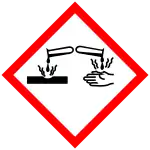 | |
| Names | |
|---|---|
| Preferred IUPAC name
Trioctyl-λ5-phosphanone | |
| Other names
Tri-n-octylphosphine oxide | |
| Identifiers | |
3D model (JSmol) |
|
| Abbreviations | TOPO |
| 1796648 | |
| ChemSpider | |
| ECHA InfoCard | 100.001.020 |
| EC Number |
|
| MeSH | Trioctyl+phosphine+oxide |
PubChem CID |
|
| RTECS number |
|
| UNII | |
| UN number | 3077 |
CompTox Dashboard (EPA) |
|
| |
| |
| Properties | |
| C24H51OP | |
| Molar mass | 386.645 g·mol−1 |
| Appearance | White, opaque crystals |
| Melting point | 50 to 54 °C (122 to 129 °F; 323 to 327 K) |
| Boiling point | 411.2 °C (772.2 °F; 684.3 K) at 760 mmHg[1] |
| Hazards[2] | |
| GHS labelling: | |
 | |
| Danger | |
| H315, H318 | |
| P264, P280, P302+P352, P305+P351+P338, P310, P332+P313, P362 | |
| NFPA 704 (fire diamond) | |
| Flash point | 110 °C (230 °F; 383 K) |
Except where otherwise noted, data are given for materials in their standard state (at 25 °C [77 °F], 100 kPa).
Infobox references | |
Trioctylphosphine oxide (TOPO) is an organophosphorus compound with the formula OP(C8H17)3. Frequently referred to as TOPO, this compound is used as an extraction or stabilizing agent. It is an air-stable white solid at room temperature.
Preparation and use
TOPO is usually prepared by oxidation of trioctylphosphine, which in turn is produced by alkylation of phosphorus trichloride.
The main use of TOPO is in solvent extraction of metals, especially uranium.[3] The high lipophilicity and high polarity are properties key to this application. Its high polarity, which results from the dipolar phosphorus-oxygen bond, allows this compound to bind to metal ions. The octyl groups confer solubility in low polarity solvents such as kerosene.[4]
In the research laboratory, both trioctylphosphine and TOPO are frequently useful as a capping ligand for the production of quantum dots such as those consisting of CdSe. In these cases, TOPO serves as solvent for the synthesis and solubilizes the growing nanoparticles. TOPO-coated quantum dots are typically soluble in chloroform, toluene, and (to a lesser extent) hexane.[5]
References
- ↑ Nakhutin, I. E. (1971). Zhurnal Obshchei Khimii. 41 (5): 940–943.
{{cite journal}}: Missing or empty|title=(help) - ↑ "C&L Inventory". echa.europa.eu.
- ↑ Kumar, Jyothi Rajesh; Kim, Joon-Soo; Lee, Jin-Young; Yoon, Ho-Sung (18 February 2011). "A Brief Review on Solvent Extraction of Uranium from Acidic Solutions". Separation & Purification Reviews. 40 (2): 77–125. doi:10.1080/15422119.2010.549760. S2CID 95358600.
- ↑ Watson, E. K.; Rickelton, W. A. "A review of the industrial and recent potential applications of trioctylphosphine oxide" Solvent Extraction and Ion Exchange 1992, volume 10, pp. 879-89. doi:10.1080/07366299208918141
- ↑ García-Rodríguez, Raúl; Hendricks, Mark P.; Cossairt, Brandi M.; Liu, Haitao; Owen, Jonathan S. (2013). "Conversion Reactions of Cadmium Chalcogenide Nanocrystal Precursors". Chemistry of Materials. 25 (8): 1233–1249. doi:10.1021/cm3035642.
